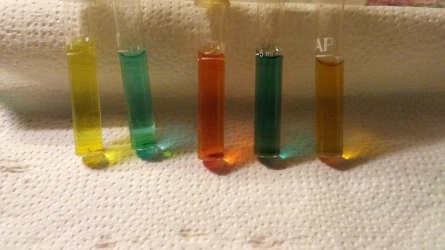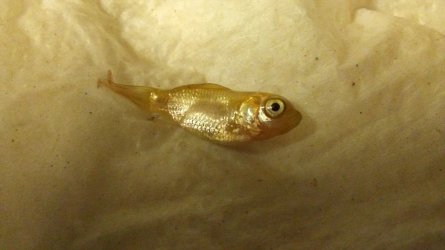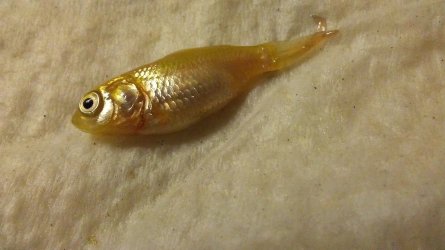It doesn't matter how many established filters are on the tank; if the tank is overstocked, there will be ammonia readings. Thus the two water changes every day.
These filters have been running since I moved the teeny tiny fry into this tank on September 5. But the filter media in them came out of those same filters two years ago when I moved my adult fish from the tank into the basement pond. I kept the established filter media in a filter bag within the pond so I would have it available if I ever needed to set up the HOB filters again.
I clean them--one at a time, not both on the same day--about once a week by unplugging the filter to be cleaned that day, removing the intake tube, swirling it in a bucket of used tank water, brushing off any gunk as necessary (using a toothbrush that has never been used for any other purpose), taking out the filter media and swirling and squeezing that in the used tank water as well, then putting everything back in place and plugging it in again.
The food in the video is gel food. It is soft and crumbles easily when the fish mouth at it. I mash it slightly in my fingers before dropping it into the tank, to make juice seep out and attract the fish to it. If I were to crumble it completely, it would be harder for the fish to locate. A lot of particles would end up in the filter instead of in the fish. And it would be impossible for me to find and remove any uneaten particles of it.
This tank is in my living room. I'll say there is much air flow in that room! This is an old drafty house with leaky windows, leaky doorframes, and no insulation. I wish there were *less* air flow from outside whooshing right through my living room! The furnace is much newer than the house, though, and there is a carbon monoxide detector in the basement and another one on the ground floor. It's never gone off. I think if there were too much carbon dioxide or carbon monoxide in my house, my dogs and cats and I would all have been susceptible to dying way before the fish arrived.
If you have 2 established filters on the tank, there shouldn't be any ammonia readings.
How long have the filters been running for?
How often do you clean them and how do you clean them?
In the video it shows a fairly large piece of food and the fish are picking at it. You are better off using small food that the fish can easily swallow. Big bits of food might not be getting eaten completely and if left to rot in the tank will produce ammonia. Perhaps try crumbling the food up so it is easier for them to eat and make sure you remove uneaten food after 5 minutes.
-----------------------
Is there much air flow in the room?
If there is too much carbon dioxide or carbon monoxide in the air, it will cause deformities in fish and make them more susceptible to dying.
-----------------------
I wouldn't bother getting more fish tested at a vet unless something major happens like you start losing fish every week.


 This one was about Floppy's size, was lying on the tank floor like Floppy was, and like Floppy, it appears to have a ridge where the lower abdomen is distended compared to the upper side. (This is easier to see on the right side of the fish.) But I don't know how long this one had been dead before I found it, so I don't know how much decomposition had gone on.
This one was about Floppy's size, was lying on the tank floor like Floppy was, and like Floppy, it appears to have a ridge where the lower abdomen is distended compared to the upper side. (This is easier to see on the right side of the fish.) But I don't know how long this one had been dead before I found it, so I don't know how much decomposition had gone on.

